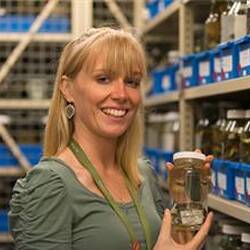Mammalogy
The Mammalogy Collection dates back to the earliest days of Museums Victoria when Sir Frederick McCoy first established the vertebrate zoology collections through purchase and exchange.
Today the collection contains nearly 40,000 specimens representing over 1100 species. These are made up of dried study skins, skulls and skeletal material, fluid specimens (containing whole animals, carcasses, internal organs and other parts), mounted skins, articulated skeletal mounts and cryogenically preserved tissues. Associated with the specimens are also data, images and literature (including field notebooks).
The collection is global in breadth with a complete collection of Victorian species and a large representation of Australian species. It emphasises Victorian mammal distribution (past and present); mammal biology and ecology; historical collections obtained on scientific expeditions; and practical applications of science relating to the history of Victoria.
Significance
The greatest strengths of the Mammalogy Collection are the taxonomic and geographic breadth of its specimens. The collection encompasses every Australian mammalian family and 89% of mammalian families globally. All Victorian mammal species are included, some of which are extinct, endangered or rare species that are not well represented elsewhere. The osteological (skeletal) collection is one of the best documented and largest in Australia, providing unparalleled access to morphological information on mammalian species across time and space. It is constantly in use by a range of research scientists including palaeontologists (those studying fossils) and neonatologists (those studying living species). The historical depth of the collection, spanning over 150 years, makes it particularly valuable for understanding biological responses over time. Many of the skins and mounts are of historical interest, having been procured from overseas sources and local exploratory trips.





